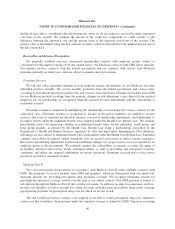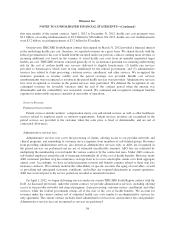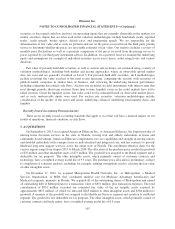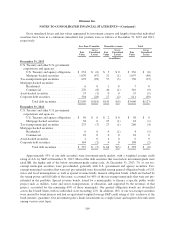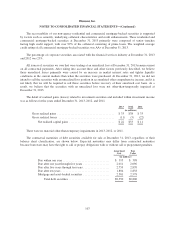Humana 2013 Annual Report Download - page 109
Download and view the complete annual report
Please find page 109 of the 2013 Humana annual report below. You can navigate through the pages in the report by either clicking on the pages listed below, or by using the keyword search tool below to find specific information within the annual report.Humana Inc.
NOTES TO CONSOLIDATED FINANCIAL STATEMENTS—(Continued)
Receivables
Receivables, including premium receivables, patient services revenue receivables, and ASO fee receivables,
are shown net of allowances for estimated uncollectible accounts, retroactive membership adjustments, and
contractual allowances.
Policy Acquisition Costs
Policy acquisition costs are those costs that relate directly to the successful acquisition of new and renewal
insurance policies. Such costs include commissions, costs of policy issuance and underwriting, and other costs
we incur to acquire new business or renew existing business. We expense policy acquisition costs related to our
employer-group prepaid health services policies as incurred. These short-duration employer-group prepaid health
services policies typically have a one-year term and may be cancelled upon 30 days notice by the employer
group.
Life insurance, annuities, and certain health and other supplemental policies sold to individuals are
accounted for as long-duration insurance products because they are expected to remain in force for an extended
period beyond one year and premium received in the earlier years is intended to pay anticipated benefits to be
incurred in future years.As a result, we defer policy acquisition costs, primarily consisting of commissions, and
amortize them over the estimated life of the policies in proportion to premiums earned. Deferred acquisition costs
are reviewed to determine if they are recoverable from future income. See Note 17.
Beginning in 2014, health policies sold to individuals that conform to the Health Care Reform Law are
accounted for under a short-duration model and accordingly policy acquisition costs are expensed as incurred
because premiums received in the current year are intended to pay anticipated benefits in that year.
Long-Lived Assets
Property and equipment is recorded at cost. Gains and losses on sales or disposals of property and
equipment are included in operating costs. Certain costs related to the development or purchase of internal-use
software are capitalized. Depreciation is computed using the straight-line method over estimated useful lives
ranging from 3 to 10 years for equipment, 3 to 7 years for computer software, and 20 to 40 years for buildings.
Improvements to leased facilities are depreciated over the shorter of the remaining lease term or the anticipated
life of the improvement.
We periodically review long-lived assets, including property and equipment and other intangible assets, for
impairment whenever adverse events or changes in circumstances indicate the carrying value of the asset may not
be recoverable. Losses are recognized for a long-lived asset to be held and used in our operations when the
undiscounted future cash flows expected to result from the use of the asset are less than its carrying value. We
recognize an impairment loss based on the excess of the carrying value over the fair value of the asset. A long-
lived asset held for sale is reported at the lower of the carrying amount or fair value less costs to sell.
Depreciation expense is not recognized on assets held for sale. Losses are recognized for a long-lived asset to be
abandoned when the asset ceases to be used. In addition, we periodically review the estimated lives of all long-
lived assets for reasonableness.
Goodwill and Other Intangible Assets
Goodwill represents the unamortized excess of cost over the fair value of the net tangible and other
intangible assets acquired. We are required to test at least annually for impairment at a level of reporting referred
to as the reporting unit, and more frequently if adverse events or changes in circumstances indicate that the asset
may be impaired. A reporting unit either is our operating segments or one level below the operating segments,
99









